Morse Code Translator
Morse code is a simple form of encoding where letters, numbers, and symbols are converted into dots and lines: use our Morse code translator to quickly encode or decode a message!
In this article, you will learn what Morse code is, when and who invented it, and how to convert to Morse code letters and numbers.
Ready? ––. –––!
What is Morse code?
Morse code is a way to encode a message composed by letters, numbers, and symbols in a series of two signals, a long and a short one, separated by varying lengths (either physical spaces, or time). It surely is not the most efficient way to encode a message. However, its simple nature made it a celebrity at the dawn of telecommunication, when it was still impossible to transmit voice over radio. formed a bond that filled the aether (and wires) for decades.
Morse code has been applied both in civilian and military settings, with most uses discontinued by the turn of the 21st century as voice became easier to transmit. Dating back to the first half of the 19th century, Morse code takes its name from Samuel Morse, who initially devised it for numbers only — the expansion to encode letters and symbols followed soon.
Telegraphists learnt and specialised in listening and transmitting Morse code messages, adopting it almost as a second language rather than a code: the "typing" speed of an experienced telegraphist is impressive to this day, making a texting teenager look slow in comparison.
This is all for a short . Let's get practical! How do we convert to Morse code? And how do we translate Morse code to English? Keep reading to see how our alphabet translates to dots and dashes!
Morse code translator: how to send a message the old way
There are no rules to translate letters in Morse code that could be used to facilitate memorization of the sequences of dots and dashes. However, the creators of the code smartly decided to assign short combinations to the most frequent letters... in the English language! This, of course, made things a bit harder for other languages that share the same Latin script.
This rule made the codes for the letters E and T the shortest: a single dot and a single dash. A, O, I, and N uses two symbols, all four possible combinations. All other letters use combinations of either three pulses (for a total of eight combinations) or four pulses (which cover the remaining 12 letters, with some combinations to spare, as the total would be 16. You can calculate these numbers using our permutation calculator).
Here is a table of Latin characters encoded according to the . You will note the absence of accented letters and other special characters, which have a naturally more difficult encoding as they depend strongly on a specific language.
Letter | Morse | Letter | Morse |
|---|---|---|---|
A |
| N |
|
B |
| O |
|
C |
| P |
|
D |
| Q |
|
E |
| R |
|
F |
| S |
|
G |
| T |
|
H |
| U |
|
I |
| V |
|
J |
| W |
|
K |
| X |
|
L |
| Y |
|
M |
| Z |
|
A quick search tells us that the word "cat" is encoded, quite briefly, with –.–. for "C", .– for "A", and the shortest – for "T".

In this image, you can see that the duration of the pulses and pauses to convert to Morse code is standardized. Here are the rules:
- A long pulse (dash, or dah) has length one;
- A short pulse (dot, or dit) has a length one third.
- The separation between pulses within Morse code letters is equal to the duration of a short pulse (one third).
- The separation between Morse code letters is equal to the duration of a long pulse (one).
- Words in a message are separated by seven thirds, that is, the duration of two long pulses plus a short pulse.
In the animation below, we show you how the length of pulses and pauses would appear in time as a lightbulb turning on and off.
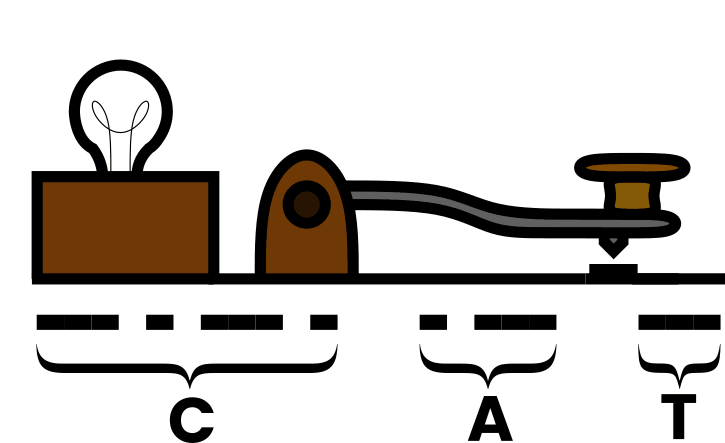
We can easily expand the table above to include the translation of numbers in Morse code. As opposed to letters, Morse code encoding of numbers can use patterns to represent the sequence 0, 1, 2, etc.
Here is the encoding of numbers in Morse code:
Number | Morse | Number | Morse |
|---|---|---|---|
0 |
| 5 |
|
1 |
| 6 |
|
2 |
| 7 |
|
3 |
| 8 |
|
4 |
| 9 |
|
Morse code can accommodate more than Latin letters and numbers: for more alphabets and symbols, we can use the .
Morse code decoder: from dots and dashes to letters and numbers
Encoding and decoding Morse code are two significantly different processes: while converting to Morse code requires memorising the codes as they match a single symbol, decoding Morse code requires making a series of "decisions" as you receive the message. A bit like this:
- You hear a dash. If this is the end of the code, this would be a "T" (
–), unless... - After a brief pause, you receive a dot. It's not a "T" anymore, possibly an "N" (
–.), or... - After another brief pause, you hear a second dot. Could it be a "D" (
––.). - The following pause is longer, so you know it's a "D".
This process is repeated for every letter and number as you proceed in a message. We can represent the series of decisions made at every step within a symbol's encoding using a binary tree (it's binary because there are only two possible values in each letter, a bit like 0s and 1s in binary code).

Using the tree is rather straightforward: We begin at "start", and take the left branch if we hear a dot, and the right one if we hear a dash. At each pulse, we move down one level.
The encoding of "Y", –.–– would then be the sequence right-down-left-down-right-down-right-down, which carries us from "T" to "Y" passing by "N" and "K".
Note how the tree is incomplete starting at the fourth level (not all four-letter codes are used), and becomes sparse at the fifth level, where only ten out of 32 codes are in use. The fifth level is used exclusively for numbers in the chosen standard.
The empty spaces can be used to encode symbols or other letters with diacritics (è, œ, ø,...).
Now that you know how to encode and decode Morse, it's time to get proficient at it: visit our page to discover !
How to use Omni's Morse code translator
We created a tool that works both as a Morse code decoder and as an encoder.
- When you are using it as a translator to Morse code from plain text, you can input letters, numbers, and symbols.
- When you are using it as a Morse code decoder, you can input dashes and dots, separated by spaces.
We try to detect what you input automatically, but we may get it wrong from time to time. When decoding Morse code, try to input only dots and dashes!
To separate pulses in Morse code letters, between letters, and words, use the following logic:
- There is no need to separate pulses within letters (e.g., the letter "P" is encoded as
.––., and not. – – .). - To separate letters in a word (e.g., "C" and "A" in "CAT"), use a single space ("AT" becomes
.– –). - To separate words in a message, use two spaces ("IN ME" becomes
.. –. –– .).
⚠️ Some operating systems add a period (a dot) when you type two spaces in quick succession. Need we say, this would mess up your Morse code decoder input? Be careful and double check your transmission, unless you want to experience some !
Translate Morse code to English: examples of famous messages
Morse code has been the backbone of communication at the dawn of this interconnected age of humanity; as such, dots and dashes blazed in cables and through the aether at many historical moments of the recent past. Almost everyone can recognize the dramatic sequence di di dit, dah dah dah, di di dit, three dots, three dashes, and three dots that encode part of the last transmission of RMS Titanic after the fatal collision with the iceberg, the now international signal of distress SOS.
Now imagine being the telegraphist of a train station in the surroundings of Halifax in the chilly winter morning of the 6th December 1917. As you begin your day, your telegraph springs to life, and you start receiving a message:
.... ––– .–.. –.. ..– .––. – .... . – .–. .– .. –. .– –– –– ..– –. .. – .. ––– –. ... .... .. .––.
Your mind flies to the binary tree, and the message begins to appear in front of you, turn after turn.
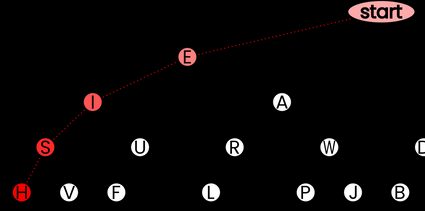
Di "E"
Di "I"
Di "S"
Dit "H"
H
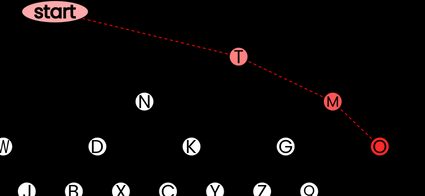
Dah "T"
Dah "M"
Dah "O"
O
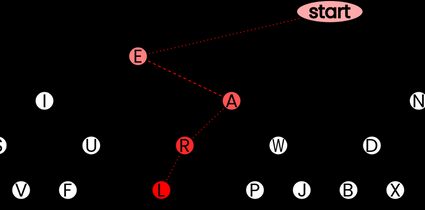
Di "E"
Dah "A"
Di "R"
Dit "L"
L
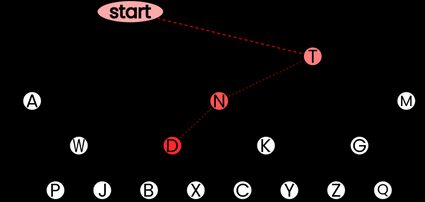
Dah "T"
Di "N"
Dit "D"
D
"HOLD"
That's a weird way to say hello. The message continues: "up the train. Ammunition ship".
A drop of sweat runs down your back as you complete decoding the message.
"Hold up the train. Ammunition ship afire in harbor making for Pier 6 and will explode. Guess this will be my last message. Good-bye boys."
The warning comes from Patrick Coleman, a railway operator at Pier 6, who just witnessed the collision between the merchant ship SS Imo and the French SS Mont Blanc, the latter laden with explosives and ammunition (it was a year before the end of WWI).
The resulting explosion remains to this day the most powerful artificial non-nuclear detonation, with an energy of 2.9 kT (2.9 thousand tons of TNT: you can learn about this unit at our TNT equivalent calculator), and wreaked havoc on the city of Halifax. Patrick Coleman perished in the explosion, but all inbound trains stopped as soon as the message arrived at the stations, saving all passengers.
FAQs
What are the components of Morse code?
Morse code is composed of two types of pulses:
- A short pulse, also known as a dot, and rendered phonetically as "di" or "dit"; and
- A long pulse, also known as a dash, is rendered as "dah".
Varying lengths of silence separate the symbols:
- A short pulse's length between each pulse;
- A long pulse's length between each letter;
- Seven short pulse lengths between words.
How do you write SOS in Morse code?
SOS in Morse code is rendered by a sequence of three dots, three dashes, and three dots. Phonetically, we write this code as "di-di-dit, dah-dah-dah, di-di-dit". The message is short and the encoding is memorable; because of this, it is often sent without breaks between letters.
Can you convert numbers to Morse?
Yes. Morse code is used to encode numbers as well as letters. The standard codes for numbers are rather regular combinations of five pulses, with 0 and 5 composed only by either dots or dashes. All other numbers have only two groups of dots and dashes with varying proportions.
What is 143 in Morse code?
143 is an unconventional way to say "I love you" that you can transmit in Morse code. 143 in Morse code doesn't correspond to the letters of I love you, but if you count, you can see that:
- I has one letter;
- Love has four letters; and
- You has three letters.
The encoding of 143 in Morse code is:
.–––– ...–– ....–